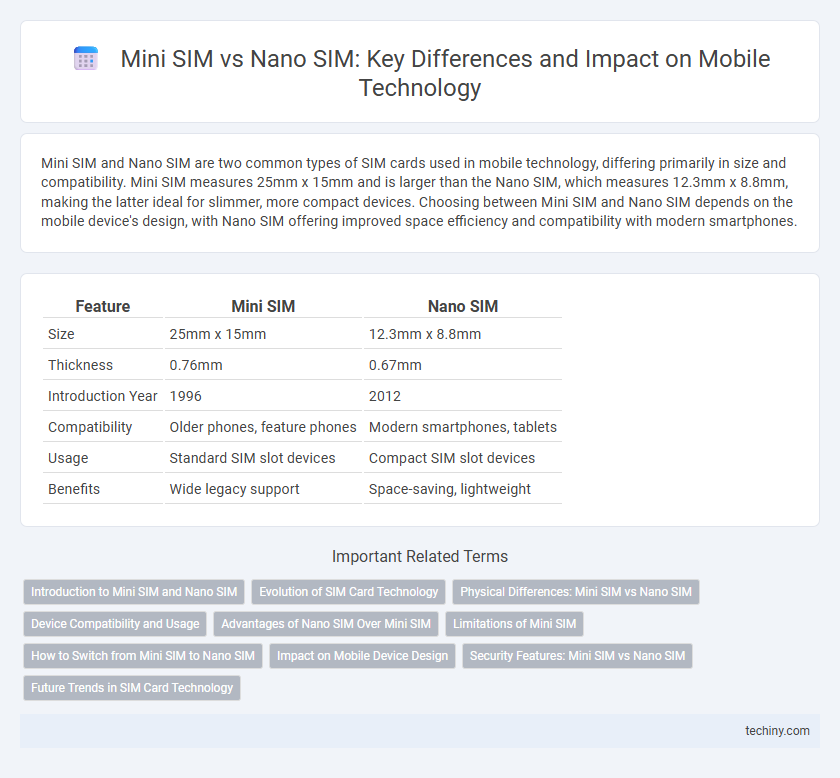Mini SIM and Nano SIM are two common types of SIM cards used in mobile technology, differing primarily in size and compatibility. Mini SIM measures 25mm x 15mm and is larger than the Nano SIM, which measures 12.3mm x 8.8mm, making the latter ideal for slimmer, more compact devices. Choosing between Mini SIM and Nano SIM depends on the mobile device's design, with Nano SIM offering improved space efficiency and compatibility with modern smartphones.
Table of Comparison
| Feature | Mini SIM | Nano SIM |
|---|---|---|
| Size | 25mm x 15mm | 12.3mm x 8.8mm |
| Thickness | 0.76mm | 0.67mm |
| Introduction Year | 1996 | 2012 |
| Compatibility | Older phones, feature phones | Modern smartphones, tablets |
| Usage | Standard SIM slot devices | Compact SIM slot devices |
| Benefits | Wide legacy support | Space-saving, lightweight |
Introduction to Mini SIM and Nano SIM
Mini SIM and Nano SIM are two common types of SIM cards used in mobile technology, differing primarily in size and compatibility. Introduced after the standard SIM, the Mini SIM measures 25mm by 15mm and was widely adopted in early smartphones, providing essential network connectivity. The Nano SIM, smaller at 12.3mm by 8.8mm, offers the same functionality but allows for more space-efficient device designs, supporting advancements in mobile hardware innovation.
Evolution of SIM Card Technology
The evolution of SIM card technology has progressed from Mini SIM to Nano SIM to accommodate the shrinking size of mobile devices while maintaining functionality. Mini SIM, measuring 25mm x 15mm, was widely used in early smartphones, but as devices demanded more internal space for components, the Nano SIM, at just 12.3mm x 8.8mm, became the industry standard. This transition exemplifies advancements in mobile technology, emphasizing increased device compactness without sacrificing SIM card capabilities such as secure user identification and network access.
Physical Differences: Mini SIM vs Nano SIM
Mini SIM measures 25mm by 15mm with a larger plastic frame, while Nano SIM is significantly smaller at 12.3mm by 8.8mm, minimizing the plastic surrounding the chip. The reduced size of Nano SIM allows for thinner devices and more efficient use of internal smartphone space. Despite the physical difference, both SIM types share identical chip dimensions and electrical contacts for compatibility.
Device Compatibility and Usage
Mini SIM cards, measuring 25mm x 15mm, are commonly used in older mobile devices and provide broader compatibility with legacy phones and basic feature phones. Nano SIM cards, at 12.3mm x 8.8mm, are designed for modern smartphones, offering a smaller footprint that allows manufacturers to save internal space for advanced components like larger batteries and enhanced cameras. Device compatibility depends on the SIM card slot size, so users must ensure their device supports the corresponding SIM card type or use an adapter to bridge the size differences without affecting network functionality.
Advantages of Nano SIM Over Mini SIM
Nano SIM cards offer a more compact size compared to Mini SIM cards, enabling manufacturers to design slimmer and more lightweight mobile devices. Their reduced thickness and smaller footprint free up internal space, allowing for enhanced battery capacity and additional hardware components. The increased durability and compatibility of Nano SIMs with modern smartphones improve user convenience and device performance.
Limitations of Mini SIM
Mini SIM cards, measuring 25mm x 15mm, pose limitations due to their larger size, which restricts compatibility with modern slim smartphones designed for smaller nano SIMs (12.3mm x 8.8mm). The bulky dimensions of Mini SIMs reduce internal device space efficiency, limiting compact device designs and advanced features integration. Additionally, Mini SIMs lack support for newer embedded SIM (eSIM) technologies essential for seamless network switching and multi-device connectivity in cutting-edge mobile networks.
How to Switch from Mini SIM to Nano SIM
Switching from a Mini SIM to a Nano SIM involves obtaining a Nano SIM card from your mobile carrier, as the Nano SIM is smaller and not compatible with Mini SIM slots without modification. Users can request a replacement Nano SIM that maintains their phone number and account details, eliminating the need for manual cutting or resizing. Utilizing a professional SIM cutter or carrier-provided tools ensures a precise fit for newer smartphones designed specifically for Nano SIM cards.
Impact on Mobile Device Design
Nano SIM cards, measuring just 12.3 x 8.8 mm, significantly reduce space within mobile devices compared to Mini SIMs, which are 25 x 15 mm. This space-saving allows manufacturers to design slimmer, lighter smartphones and allocate more room for advanced components like larger batteries and improved cameras. The transition from Mini SIM to Nano SIM has thus enabled more compact and efficient mobile device designs without compromising functionality.
Security Features: Mini SIM vs Nano SIM
Nano SIM cards incorporate advanced security features such as enhanced encryption algorithms and improved tamper resistance compared to Mini SIMs, reducing the risk of cloning and unauthorized access. The smaller form factor of Nano SIMs enables integration with modern mobile devices that support more secure authentication protocols like biometric verification and secure element technology. Mini SIMs lack these sophisticated protections, making Nano SIMs more reliable for safeguarding sensitive user data and ensuring secure mobile communications.
Future Trends in SIM Card Technology
Nano SIM cards, smaller and more efficient than Mini SIMs, are setting the standard for future mobile technology due to their compact size and compatibility with advanced devices. Emerging trends indicate a shift toward embedded SIMs (eSIMs) and integrated SIM technology, which offer improved security, remote provisioning, and better integration with IoT devices. The mobile industry is prioritizing these innovations to support seamless connectivity and enhanced user experiences in next-generation wireless networks.
Mini SIM vs Nano SIM Infographic

 techiny.com
techiny.com